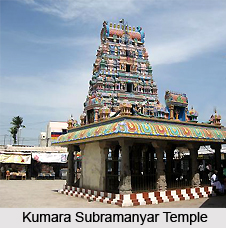 Kumara Subramanyar temple is dedicated to Lord Muruga. It is believed that Lord Muruga resides on hills. It is also considered that the Lord gives darshan with 5 faces and eight arms. The five faces indicate his simmilarity with Lord Shiva. The Lord of is also known as Sivakumaran and Kumarasivam.
Kumara Subramanyar temple is dedicated to Lord Muruga. It is believed that Lord Muruga resides on hills. It is also considered that the Lord gives darshan with 5 faces and eight arms. The five faces indicate his simmilarity with Lord Shiva. The Lord of is also known as Sivakumaran and Kumarasivam.
It is believed that Lord Muruga revealed, recited the meaning of the Pranavam "OM" to his father Lord Siva on this hill & hence the name "Odhi Malai". Lord Brahma had walked away beside Lord Muruga without greeting him. This angered Muruga wanted to teach him a lesson & asked him to tell him the secret of Creation & when Brahma answered that the Pranavam "OM" was the basis for all creation, he asked him to explain the meaning of "OM". Muruga gave a knock on Brahma`s head & put him in a prison at Irumbarai. Lord Siva pacified him & released Brahma from the prison.
Initially Lord Muruga at Odhimalai is said to have had 6 faces & 12 arms. Bhogar was performing yagna which is near to Odhimalai. Lord Muruga gave darshan after he had completed three yagas. Bhogar wanted to reach Pazhani but did not know the way. Muruga took a form with one face & four arms and led him towards Pazhani. He stopped at a place which was about 4kms from Odhimalai and gave further directions to Bhogar to reach Pazhani and vanished. The Murugar idol in this temple at Kumarapalayam is seen with 1 face & 4 arms. The Lord resides at Odhimalai with the remaining 5 faces & eight arms.
There are around 1,880 steps to reach the temple that is situated on the hill. On the way there is a sannadhi for Lord Ganesha. There are separate sannadhis for Naagar, Idumban, Viswanathar, Visalakshi, Rajarajeswari, Sapthamathas. As the Muruga of this temple is a young lad, the vehicle behind the idol is considered to be Indra in the form of the peacock. He has one foot forward. The right lower arm is in abhaya mudra & the left lower arm is in varada mudra. He holds the sword, arrow and vajram in the right hand. In the left upper arms he holds the shield, bow and paasam.





















